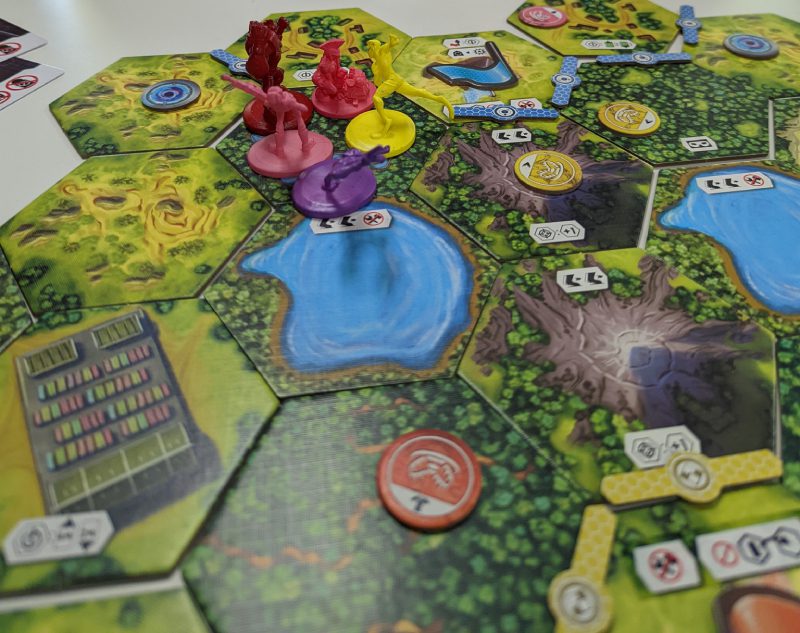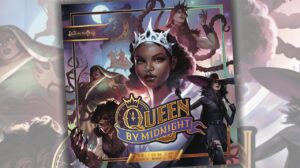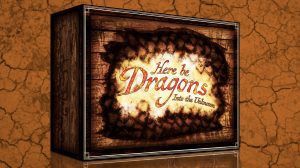If you were to ask me what my childhood was like, I only have three words for you: First person shooter. Since my elementary school days playing Wolfenstein 3D, moving on to Doom, and now barely functioning in Apex Legends, the first-person shooter genre has kept me tied up in a room for years like I’m in a Stephen King novel.
Due to my odd emotional attachment to the genre, it is amusing to see the numerous attempts by board game designers and publishers to translate a first person shooter into a board game. How do you adapt a genre known for its reflexes, spatial awareness, and 3D space into cardboard form? According to the games I’ve played, not very well. Maybe Reload might change my perception.
Keep in mind that this is not a review copy. Initially, I was supposed to get the base game for review, but due to logistics difficulties, it didn’t happen. Someone was selling this game along with the Rumble and Capture the Flag expansion in shrink at a great price, so I dived in.
In the year 20XX…
As for the game’s story, it’s not exactly detailed. It’s future time and to everyone’s surprise, bread and circuses are still popular. This is a battle royale where the violent, hungry crowd gets their three-course meal while the corps behind the scenes get to see their experiments in a live field. You, the contender, don’t care about any of this nonsense. You want fame and that includes making your opponents’ organs experience the fresh outdoors.
To keep track of the upcoming bloodbath, everyone has a Fame track. If you reach the end, you immediately win and if the timer runs out, whoever has the longest Fame track wins. Even though this is a battle royale, you can earn Fame without turning the battlefield into Patrick Bateman’s apartment. You can achieve public objectives, set traps, or disarm your opponent’s traps. Beacons litter the battlefield, and you can grab them, run towards the middle, and dunk them for extra points. Also, dying is not the end, as you simply “Reload” at the start of your next turn.
Hexagonal tiles make up the map, and the game offers a book of pre-made maps or you can create your own. Event cards not only serve as the game’s timer but also throw in random incidents such as radiation spreading, more loot or beacon tokens, and earthquakes.
Planning your kill
Turns are easy to grasp. You have five action dice and you will assign them to different areas on your player mat to execute your actions. There is no dice rolling in this part of the game. For example, if you have to use the Run action twice, the first action is a 4, while the second action is a 3.
Besides the Run action, you can build, activate a tile you are on, loot tokens, heal yourself, or perform combat. After you have taken all your actions, all used dice go into your Battle Line from highest to lowest, while the unused dice go to your Defense Pool.
The purpose behind the Battle Line is to act as your defense outside of your turn. Whenever someone attacks you, you use your Battle Line, while the unused dice in your Defense Pool are rolled and added to the Battle Line. As in Risk and Spartacus, you compare dice results from highest to lowest roll if your result is higher than the defense, you score a hit. Range attacks are safe for attackers, whereas Melee attacks can damage both sides. Throw in equipment that can fudge the results and a Skull result on the die that acts as a critical hit, and you have a surprisingly engaging system that anyone can easily understand.
What I truly love about this entire setup is the restraint. Here you are, thrown into a situation where you can score in multiple ways, have limited rounds, and numerous actions to take. The more actions you take, the more vulnerable you are, thus forcing your mind to attend an arena of decisions and trying to figure out which one will win. This is all accomplished through a fairly simple set of rules.
At least it would be easy if the rulebook or the rest of the production wasn’t a mess.
When I mean by production, I don’t mean artwork. If anything, the character designs are top-notch with their unique silhouettes, diverse body types, and color schemes.
The problem is everything else.

Hitting the sauce, hard
Since this is a board game review, I must complain about the rulebook. Reload is originally a French game so translation errors will happen. The problem is the game is explained in an awkward way or leaves way too many interpretations like you’re reading a religious document. To put this into perspective, I reviewed Galactic Era a few weeks ago, a complicated 4x space game with a 40-page rulebook. I understood that game after reading it twice whereas here I am still skeptical if I am playing Reload correctly after playing it several times.
This frustration embeds itself into the player references. Reload abuses the power of symbols. The player aids, much like the rulebook, have an odd way of explaining the details. It also has a misprint on one of the event cards, adding more confusion.
I wish I could stop here, but I can’t ignore the miniatures. The material they used is more flexible than a chapter in the Kama Sutra. According to the note in the bag during unboxing, this is to prevent the miniatures from breaking. The side effect of this decision is the miniatures will likely be bent when you pull them out and need to use warm water to bend them back into place.
That isn’t an extreme issue for me because the big problem here is the colors. If you get the expansions, the colors of some of the characters are too close to each other, almost as if it was designed to trigger a seizure in a colorblind basset hound.
The last bit of complaint I have, at least in the base game, is the Fame track itself. It’s weird because I like the concept. Whenever you do something interesting like injure someone, murder them, or score a beacon, you slot a token into your Fame track. At its core, the Fame track is a colorful scoreboard and serves as a timeline of your successes and failures in the match. Visually, it looks great. However, a few games later, I started to feel the consequences of this decision. What consequences? Over 200 tokens.
I’m sure fans of GMT Games are laughing at that statement, but this does hurt the game in terms of setup and teardown, compounded by an inadequate insert if you buy the expansions.
Yet despite spending the past few paragraphs complaining about the game, Reload’s design devours its competition, spits out their bones, and constructs a throne with them. It’s that good.
A proper redemption
The first two games that came to mind were Last One Standing and Adrenaline.
Last One Standing is perhaps the closest thing the board game industry has to a battle royale. You have eight players and player elimination. Players will stroll through the hexagonal map to grab the loot and shoot each other. Combat is deterministic, meaning you simply check the range, and they get damaged. The problem here is it reduces the game into funky hand management with a boring movement system.
Adrenaline is the biggest disappointment of them all. At first glance, the artwork captures the spirit of Unreal Tournament and Quake in a Chinese finger trap. Much like CGE’s Diablo-inspired Sanctum, the game’s artwork is strictly a mirage for a different experience. In Adrenaline’s case, it’s merely grabbing colored cubes, and spending said cubes to shoot your gun to damage your opponents. Nothing else.
Due to an allergy to anything random, such as dice, both games leave the players in a repetitive and lifeless experience. This doesn’t make any sense in a game that is trying to emulate the shooter genre since shooters tend to have various degrees of success and failure due to numerous variables.
Tell me the odds
While dice aren’t always the answer, Reload makes clever use of them. The Battle Line system means you control the amount of risk, and any decision you make will have a chance of failure. It makes sense to do this in a free-for-all game since the old standby of “kill the lead player” might actually backfire and keeps everyone on the edge.
The dice aren’t the only piece of randomization here. When you get equipment, you draw from a deck of cards. Equipment can be anything from range or melee weapons, tool kits, grenades, healing, and so forth. In other words, your character might only be able to find a collapsible baton, a military vest, and an energy drink, making the character better suited to fight an LA motorist than a battle royale contender. And you know the funny part? This can work.
While I am making it sound like everything is random, there are some deterministic elements that cement all of this together. When you perform a Build action, you can either build two walls, a single hideout, or place a trap. If you end your turn at a hideout, you are protected from radiation and get a defensive bonus. When a player goes into a space with an enemy trap, they literally play a game of rock paper scissors to determine whether they go away free, get injured, or can’t move for the rest of the turn. Walls block movement and line of sight for firing unless it is yours.
Because of the incredible utility behind the Build action, the collective decisions of the players will constantly force the state of the map to move around like a child in a toy store. Walls force detours on optimal paths while traps slow people down. If you play in teams, this is another layer of collaboration as you discuss with your teammate where to build.
Throw in the random events that mess the situation even further, and you have a dynamic game. Downtime isn’t even an issue here since you are intellectually invested to see what will happen and what opportunities you can exploit like a “friend” getting hurt after a melee fight.
Obviously, I love this game, but I did mention the expansions, so I guess I have to talk about them, don’t I?

Involuntary blood donation
Let’s start with the easy one, the Rumble expansion. It’s simply a 5-6 player expansion with four new characters. Besides having the obvious free-for-all with a higher player account, you can now have 3 vs 3 teams or 2 vs 2 vs 2. The game is already great as a free-for-all, but the team play element adds so much. Team composition, loose diplomacy, and questionable coordination are part of the play, and it works. I still prefer the game at four players due to a faster pacing, but the extra characters are a nice addition. I must give one hell of a warning that downtime is far more noticeable here, as it can easily take ten minutes between turns and some session can easily last up to two hours. I can see some players liking this and I’m not one of them.
I can’t say the same about the Capture the Flag expansion.
As the name of the expansion implies, your team’s job is to take the enemy flag from their base and deliver it to your base, while defending your own flag. A simple concept, yet a sloppy execution.
The first problem is while you do get a gigantic Fame token for capturing the flag, you still get Fame tokens for everything else such as traps, injuring, and killing. Grabbing the flag is hard since it’s so painless to barricade the flag with traps and walls. The amount of coordination and effort doesn’t warrant the reward when you can just blast each other instead. Out of the three games I’ve played in Capture the Flag, we never touched the flag once. Mind you, we played 3 vs 3 Capture the Flag, meaning more firepower, but it still left a sour experience.
Perhaps the worst offender is the absence of the Event deck. Instead of a deck of cards, you simply get these purple timer Fame tokens. At the end of your turn, if your flag is still at your base, you score it.
Capture the bore
What’s happening in this setup is the removal of the dynamic gameplay of the original mode. The narrative surrounding this chaotic battlefield is absent, and events no longer shake up the situation. Instead, you have a sterile playthrough that feels like an awkward euro game.
Also, plenty of misprints here. There are stickers to fix the flag base tiles, but there aren’t enough stickers. The book containing the maps also has several misprints regarding the starting tokens on the village tiles. Quality control did not exist here.
Nevertheless, I am not completely against grabbing this since it does add four new characters, more equipment cards, and a handful of hexagonal tiles for the map. More content is good content if the game is enjoyable.
And yeah, Reload is enjoyable. I’ve played plenty of free-for-all games, and Reload easily sits at the top. Lots of ways to score, a satisfactory variety of maps, and rules that almost anyone can get into. Don’t get me wrong, it’s not perfect since the rulebook is terrible, the symbols are annoying, and the miniatures are nonsense. Yet, I cannot ignore my feelings towards the design since I always look forward to playing with my friends, and games are often filled with laughter and cheers. It’s hard for me not to suggest trying this game out if you don’t mind the heavy dosage of randomness alongside the free-flowing bloodlust.












Add Comment